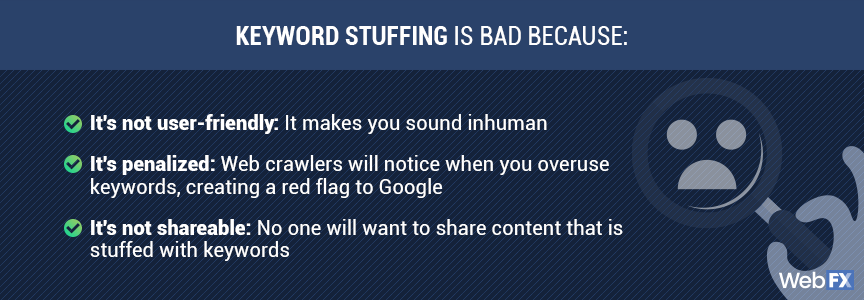What Is Keyword Stuffing?
What is keyword stuffing?

Keyword stuffing is the practice of saturating (or stuffing) a page with keywords to try and increase that page’s ranking in search results on search engines like Google and Bing. These keywords can appear in a few areas, including within content, in separate lists, and more.
Even though keyword stuffing doesn’t work anymore (it’s now seen as a black-hat SEO tactic), many companies accidentally engage in keyword stuffing when beginning SEO. While it’s an honest mistake, that mistake can cost businesses their rankings in valuable search results.
That’s why learning what keyword stuffing is, as well as how to avoid keyword stuffing in SEO, is essential. This helpful, brief guide offers you everything you need to know about using keywords. Now that we’ve answered the question, “what is keyword stuffing?” keep reading to get up-to-date on keyword stuffing, as well as see some keyword stuffing examples!
We’ll cover:
- Examples of keyword stuffing
- Why keywords are important
- Why keyword stuffing is bad
- How to avoid keyword stuffing
If you need help with your SEO strategy, consider WebFX. Browse our SEO keyword research services, which have helped our clients earn more than $10 billion in revenue in the past five years, or contact us online (you can also give us a ring at 888-601-5359) to learn more about how our experienced team can help!
We foster and form long-term partnerships so that your business has long-term results.
Over 90%
Examples of keyword stuffing
Below, you can see an example of keyword stuffing. The keyword, in this case, is “yellow rubber ducky.”
“Get a yellow rubber ducky for your children. A yellow rubber ducky is a charming toy, so buy a yellow rubber ducky today. With a yellow rubber ducky , you can have tons of yellow rubber ducky fun. It’s easy to make bath time great with a yellow rubber ducky , and a yellow rubber ducky from our company guarantees yellow rubber ducky enjoyment.”
This paragraph has plenty of problems, such as:
- Keyword density: The keyword “yellow rubber ducky” has been used eight times in a paragraph with 61 words. That’s unacceptably high, and it’ll earn a penalty from search engines.
- Audience targeting: The paragraph isn’t written conversationally for people to read. It’s meant to trick Google’s search engine crawlers. Any visitor who comes upon this paragraph is going to be immediately turned off by it and leave the site.
- Content purpose: There’s really no sense of organization or cohesion in the paragraph. It’s just a place to use the keyword “yellow rubber ducky.”
Writing your content with an audience-first perspective, as well as proofreading your content, can help you spot keyword stuffing.
Why keywords are important?
To understand keyword stuffing, you have to think about keywords in general.
Keywords are used to help people find pages on your website.
For instance, if you’re selling rubber duckies, you don’t want visitors coming to your page if they want garden hoses or furniture — you want visitors who are interested in rubber duckies.
With that in mind, all your web pages should contain text that has something to do with keywords surrounding rubber duckies. The same is true of any web-based advertisements, such as pay-per-click (PPC) services and SEO strategies.

You have a lot of different ways to figure out which keywords are right for your business, from using software to working with Internet marketing firms. You can even use your strongest competitors’ information to see what keywords they’re using.
Regardless of how you get them, once you have them, you can begin inserting them into your website’s text. And that’s when the topic of keyword stuffing comes into play.
Why is keyword stuffing bad?
When people first started using SEO, search engines weren’t sophisticated enough to filter the reputable sites from the ones that just wanted traffic. That’s why people began spamming keywords all over their website. It got them traffic while they cheated the system.
Today, that doesn’t work anymore.

Search engines can tell when someone’s spamming keywords on a site, and they actively penalize those sites in search results. Don’t feel tempted by keyword stuffing. It will hurt your website, traffic, and business.
Now, let’s summarize why keyword stuffing is bad:
- Keyword stuffing isn’t user-friendly: When you stuff keywords into your content, it sounds inhuman. People won’t read your content because it’s difficult to read. If they can’t read your content, they won’t stay on your site, which will decrease your rankings further.
- Keyword stuffing is penalized: Web crawlers will notice that you’re overusing certain keywords. This is a red flag that leads to a penalty. Google penalties range from demoting a page in search results to banning your whole site from Google’s index. If you do a lot of business online, you can lose a lot of customers.
- Keyword stuffing isn’t shareable: Keyword-filled content isn’t shareable, so if you’re writing a blog post or article, no one will want to share it. In a world where social media can play a huge role in getting your business noticed, it’s essential to create content that people like, so you can build your brand.
Now that you know why keyword stuffing doesn’t work, let’s discuss how you can avoid it.
How to avoid keyword stuffing
If you want to avoid keyword stuffing, you just have to write text for your website like you’re writing an email.
Be direct, use concise language, and get to the point quickly. You may not use the keyword 30 times on a page, but that’s okay — you want people to be able to read it easily.
Both Google and your site visitors will appreciate the fact that you’re writing for human readers, as opposed to search engine crawlers. And when you do, they’ll show your page in search engine results pages (SERPs) much more often than a site that stuffs keywords.
WebFX knows how to do SEO without overloading keywords
At WebFX, we have a full team of seasoned experts who know how to attract new customers to your site without stuffing it with keywords. They’ll write all of your pages conversationally and include keywords naturally throughout the text, ensuring you show up in search engines for valuable keywords and grow your brand. With that kind of expertise, you can grow your business steadily over time.
Contact us today to create an SEO and content strategy for your company!
Related Resources
- What is Internal Link Building? (And How to Build Your Internal Link Building Strategy)
- What is Keyword Cannibalization?
- What is Keyword Density? [+4 Best Practices for Optimal Density]
- What is Keyword Stemming?
- What is Link Building? Beginner’s Guide to Link Building for SEO
- What is Mobile-First Indexing? Learn How to Optimize for Google Mobile-First Indexing
- What is My SEO Score? (Plus 9 Factors That Affect It)
- What is Natural Language Processing (NLP)?
- What is Off-Page SEO?
- What is Search Retargeting and How Does It Work?
Marketing Tips for Niche Industries
- Turn Clicks into Contracts with High-ROI PPC for Manufacturers
- Urgent Care Marketing Ideas: 5 High-ROI Tactics
- Vision Care Industry Statistics
- WebFX: Your Education Digital Marketing Agency
- What is Patient Acquisition Cost & How Do You Calculate It?
- Why Auto Part Retailers Need Digital Marketing
- Why Digital Marketing is Essential for Auctioneers
- Your 2025 Guide to Digital Marketing for Home Security Companies
- Your Guide to Digital Marketing for Exercise Equipment Companies
- 2025 Professional Services Trends: Embracing the Future












